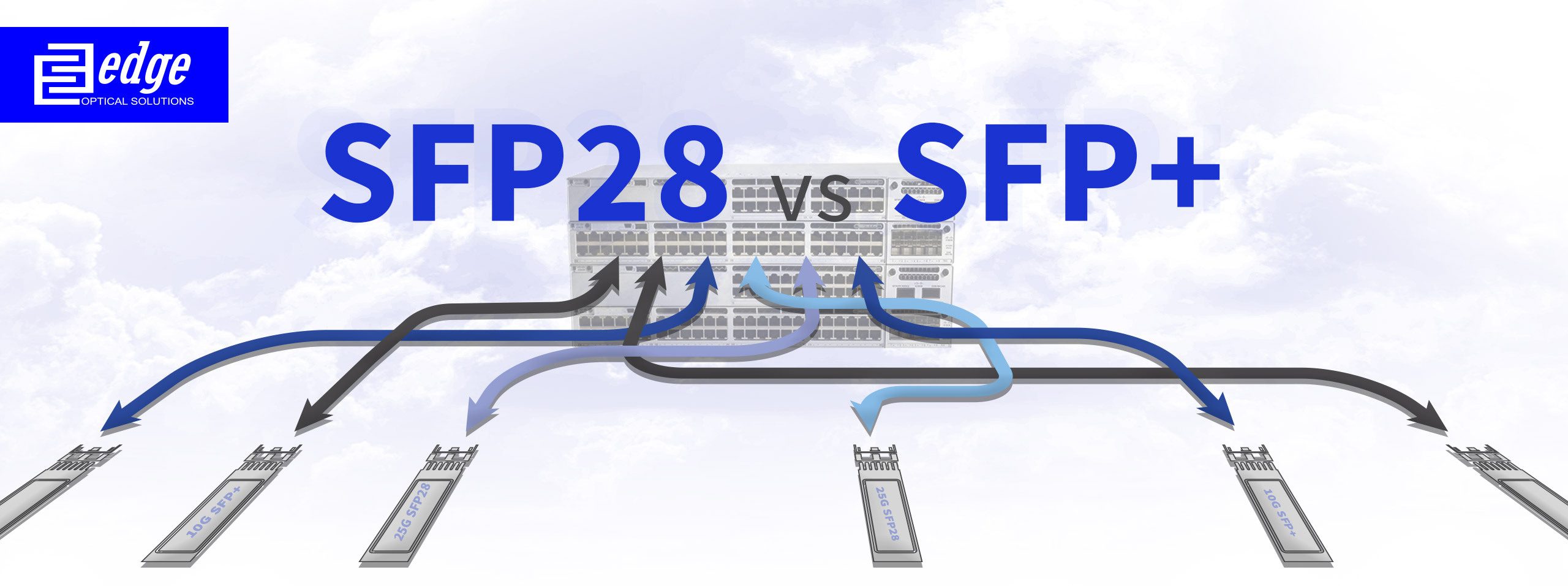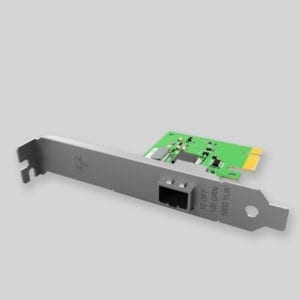
Is SFP28 compatible with SFP+?
Is SFP28 compatible with SFP+? Can SFP28 run at 10gb speeds? Can you plug SFP+ into SFP28 ports on my switch? These are some of the questions we hear from customers quite often. SFP28 transceivers are nothing new in the market, but somehow we feel that there is quite a lot of uncertainty on different application aspects between these different (but in real life almost identical) form factors – SFP+ and SFP28. In this article we will try to answer all common questions on 10/25Gbe SFP28 cross-compatibility.
What is SFP+ transceiver?
SFP+ (also known as Small Form Factor Pluggable Enhanced) is a hot-swappable optical transceiver, and is a type of transceiver used in high-speed networking applications. It is designed for data rates from 8.5 Gbps up to 10.3 Gbps and is commonly used in 10 Gigabit Ethernet and Fibre Channel applications. SFP+ transceivers provide the uplink interfaces, laser transmission (Tx) and receiver (Rx), and it supports 850 to 1610 nm nominal wavelengths, depending on the used transceiver.
The SFF-8431 specification is a standard that defines the form factor and electrical interface for SFP+ transceivers. It was developed by the Small Form Factor Committee, a group of companies that collaborate on the development of standards for small form factor optical and electrical transceiver modules. The SFF-8431 specification ensures that SFP+ transceivers from different manufacturers are interoperable and can be used in the same systems.
10G Ethernet and other popular protocols – 10 Gigabit Ethernet (10 GbE) is a networking standard that supports data rates of up to 10 Gbps. It is the most widely used high-speed networking technology and is commonly used in datacenters, enterprise networks, and other applications that require high-speed connectivity.
Other popular protocols that are used in high-speed networking applications include 25 Gigabit Ethernet (25 GbE), 40 Gigabit Ethernet (40 GbE), and 100 Gigabit Ethernet (100 GbE). These protocols are enhancements of the 10 GbE standard and support higher data rates to meet the growing demand for more bandwidth. Fibre Channel is another protocol that is commonly used in storage area networks (SANs) to transfer data between storage devices and servers. These protocols are all based on the Ethernet standard and use similar networking technologies, but they are optimized for different applications and data rate requirements.
What is SFP28 tranceiver?
Same Form Factor With Different Speed – SFP28 and SFP+ transceivers are both small form-factor pluggable transceivers, meaning they have the same physical size and shape. However, the main difference between the two is the data rate they support. An SFP28 transceiver can achieve higher data rates than an SFP+ transceiver.
Other popular protocols that are used in high-speed networking applications include 40 Gigabit Ethernet (40 GbE), 100 Gigabit Ethernet (100 GbE), and Fibre Channel. 40 GbE and 100 GbE are newer standards that support even higher data rates, while Fibre Channel is a protocol that is commonly used in storage area networks (SANs) to transfer data between storage devices and servers. These protocols are all based on the Ethernet standard and use similar networking technologies, but they are optimized for different applications and data rate requirements.
The 25G-SFP28 transceiver is based on SFF-8402, which states that SFP28 is a type of transceiver used in high-speed networking applications. It is an enhanced version of the SFP+ transceiver that supports data rates of up to 25 Gbps. The SFF-8402 specification is a standard that defines the form factor and electrical interface for SFP transceivers, including SFP28 transceivers. The SFF-8402 specification ensures that SFP28 transceivers from different manufacturers are interoperable and can be used in the same systems.
Important Role of 100G-QSFP28 coexistence (Can connect to SFP28) – 100G-QSFP28 breakout to SFP28 refers to a technique that is used to connect 100 Gigabit Ethernet (100 GbE) devices using QSFP28 transceivers to devices that use SFP28 transceivers. QSFP28 is a type of transceiver that supports data rates of up to 100 Gbps and is commonly used in 100 GbE applications. SFP28 is a type of transceiver that supports data rates of up to 25 Gbps and is commonly used in 25 GbE applications.
To connect a 100 GbE device using a QSFP28 transceiver to a 25 GbE device using an SFP28 transceiver, a breakout cable can be used. A breakout cable is a special type of cable that has a QSFP28 connector on one end and four SFP28 connectors on the other end. The QSFP28 connector is plugged into the 100 GbE device, and the four SFP28 connectors are plugged into the 25 GbE device, allowing the two devices to communicate at a data rate of 25 Gbps. This technique is useful in situations where a 100 GbE device needs to be connected to multiple 25 GbE devices, or when a 25 GbE device needs to be connected to a 100 GbE device but does not have a QSFP28 port.
Recognizing the difference between SFP+ and SFP28 Transceiver
Both SFP+ and SFP28 transceivers share the same physical dimensions, making them mechanically compatible. The primary distinction lies in their data rate capabilities:
- SFP+: Supports data rates up to 10 Gbps and is commonly used in 10 Gigabit Ethernet and Fibre Channel applications.
- SFP28: Supports data rates up to 25 Gbps, making it suitable for 25 Gigabit Ethernet applications.
Despite their similar form factors, it’s essential to consider electrical compatibility and the intended application when interchanging these modules.
Can SFP28 Modules Operate at 10 Gbps Speeds?
Yes, SFP28 modules can operate at 10 Gbps speeds. However, their performance at this reduced data rate depends on the specific module and the equipment it’s connected to. While some SFP28 modules are designed to support backward compatibility with 10 Gbps, others may not perform optimally at lower speeds. It’s crucial to consult the manufacturer’s specifications to ensure proper functionality
Can You Plug SFP+ Modules into SFP28 Ports?
In many cases, SFP+ modules can be inserted into SFP28 ports due to their identical physical form factors. Most SFP28 ports are designed to support SFP+ modules, allowing for 10 Gbps operation. However, this compatibility is not universal. Network equipment manufacturers may have varying specifications regarding module compatibility. Therefore, it’s advisable to verify compatibility with the equipment vendor before deploying mixed configurations.
Is 25G SFP28 capable of rate-adaption down to 1G? (Can SFP28 run at 1Gbps?)
It depends on the specific 25 Gbps SFP28 transceiver and the host device it is being used with. Some 25 Gbps SFP28 transceivers may be able to support data rates of 1 Gbps through a process called rate-adaption, while others may not. Rate-adaption allows a transceiver to adjust its data rate to match the capabilities of the host device it is connected to, allowing it to operate at different data rates depending on the situation.
However, not all 25 Gbps SFP28 transceivers are capable of rate-adaption, and not all host devices support it. To determine whether a specific 25 Gbps SFP28 transceiver is capable of rate-adaption down to 1 Gbps, you would need to consult the documentation for the transceiver and the host device. It is also worth noting that even if a transceiver is capable of rate-adaption, it may not perform optimally at lower data rates, so it is always best to use the correct transceiver type for the intended application.
What does 28 means in SFP28?
A lot of people call the same thing different ways – 25G Transceivers, SFP28, 25G SFP! Many wonder why it is called SFP28, not SFP25 – The reason why the transceiver is called SFP28 and not SFP25 is because the “28” in the name indicates the maximum data rate that the transceiver is capable of supporting, not the exact data rate that it is designed for. SFP28 transceivers are designed to support data rates of up to 25 Gbps, but they are capable of supporting higher data rates up to 28 Gbps if the host device and the network infrastructure support it. The “28” in the name is a way to differentiate SFP28 transceivers from other types of transceivers that may have different data rate capabilities.
If You have noticed some inaccuracies or there are still left unanswered questions on topic of SFP28 vs SFP+ – let us know! We are ready to learn together and will update our knowledge base!
 Allied Telesis AT-2914SP-001
Allied Telesis AT-2914SP-001

